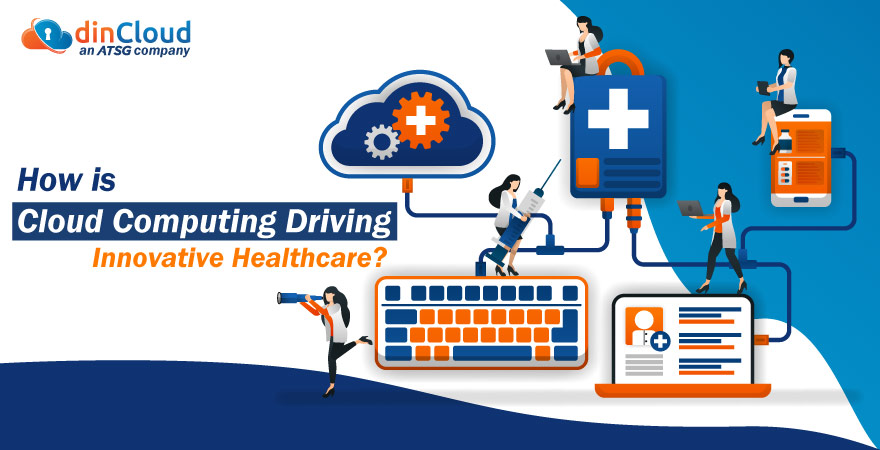The healthcare sector has massively evolved over the past few years, especially after the pandemic. Healthcare providing institutions and professionals were at the forefront of the pandemic response all over the globe.
However, a lot of the measures healthcare providers took in specific response to the Covid-19 pandemic are now being adopted across the board. In this post, we will discuss some of those major changes, and how Cloud Computing is at the forefront of this change.

Cloud Powered Telehealth Services Proliferate
Initially, telehealth services were started in a bid to manage the immense patient load, and keep frontline healthcare providers out of harm’s way. Now, telehealth has been adopted as a mainstream delivery vehicle for remote healthcare and patient management.
The Cloud acted as the enabling ecosystem between thousands of patients and their healthcare providers. All this happened without any physical contact, while still delivering decent results, despite being a relatively new experiment at such a mass scale.
Digitalization of Patient’s Medical Records
Healthcare providing institutions had previously been wary about moving sensitive medical records of patients over to the Cloud. They felt more comfortable keeping such sensitive data on-premise, but all this has changed post pandemic.
Leading Cloud Service Providers (CSP) like dinCloud have been able to demonstrate exceptionally robust cyber security and data privacy, despite the extremely hostile cyber security environment we are witnessing right now.
This has given leading healthcare providers across the globe a lot of confidence in public cloud security. As a result, we are seeing an increasing number of healthcare providers moving sensitive medical records and data over to the Cloud.
Easy and Fast Track Healthcare Delivery
With medical histories and records making their way to the Cloud, it is becoming much easier for patients to seek the medical advice of top practitioners and physicians, even if they are based in a different city, country or continent altogether.
This would not have been possible so easily without innovative Cloud Computing solutions that allow rapid and secure sharing of even sensitive data like medical records. With easy data sharing, patients can consult the physician that best suits them, even if its afar.
Remote Monitoring of Patients
During the pandemic, we witnessed hospitals across the globe reach full capacity within weeks of the outbreak. Most hospitals were operating well beyond their designed capacities during the peak of the pandemic.
This situation has paved the way for remote monitoring of patients that are not in need of critical care, but still cannot be left un-attended. Specialized medical devices are constantly feeding key patient metrics to the relevant healthcare providers.
This data is easily being aggregated over Cloud Computing infrastructures, and is being benchmarked against the normal values for patients with similar ailments. As a result, most of the care and monitoring can now be performed outside hospitals.
Realizing the Goal of Digital Health Equity
On the whole, healthcare is a really expensive undertaking, even for the developed economies of the world. So far as the developing world is concerned, which otherwise has population crises alongside as well, healthcare is reserved for the wealthy few.
Well, Cloud Computing stands to change this in a big way, as by leveraging the Cloud for their healthcare operations, leading health providing institutions are able to cut down their costs, IT related overheads, all while enhancing their capability to serve patients.
This in turn is making healthcare much more affordable and accessible for the masses, even for the lower income segments of the society across the globe. Easier and better access to healthcare globally means a much improved overall quality of life.
Leveraging Cloud and AI for Medical Breakthroughs
Healthcare providers across the globe have been investing millions and billions of dollars in health related Research and Development (R&D). The time, effort and resources that go into researching the cure for diseases are astronomically high.
Under these circumstances, it would be impractical to provide affordable remedies or treatments to the masses. This is where the cost effective storage and processing capabilities of Cloud Computing come into the picture.
Cloud Computing, when used with technologies like Artificial Intelligence (AI), are paving the way for super fast and low cost disease research. The best and most recent example is how the Cloud helped in rolling out a viable vaccine for Covid-19 in a record low time.
Conclusion
Whether its telehealth, digitalization of medical records, medical research and development (R&D) or affordable healthcare services, Cloud Computing is playing the role of a key enabler for all these.
We will continue to witness a rising role of the Cloud in the global healthcare sector over the months and years to come. This in turn will improve the overall life expectancy of the masses globally and also improve their quality of life.
Now, diseases and outbreaks are becoming much more contagious, transmittable and deadly, owing to the super fast means of transport. It is imperative that the healthcare sector takes the lead, and technologies like Cloud Computing will really help.
Contact dinCloud, an ATSG company, which offer a wide range of Cloud Computing solutions and services that are independently certified as being safe for use by regulated sectors like healthcare.


